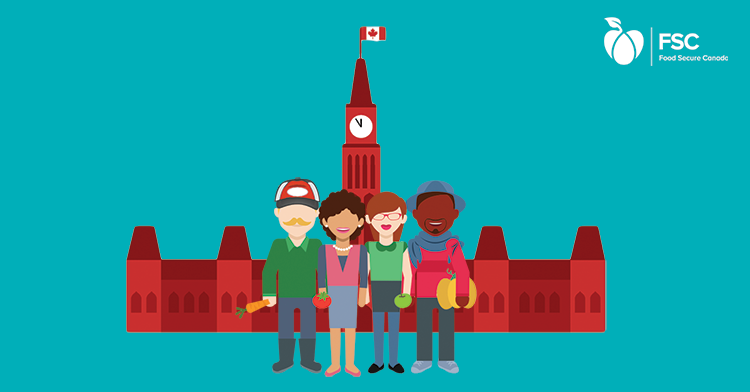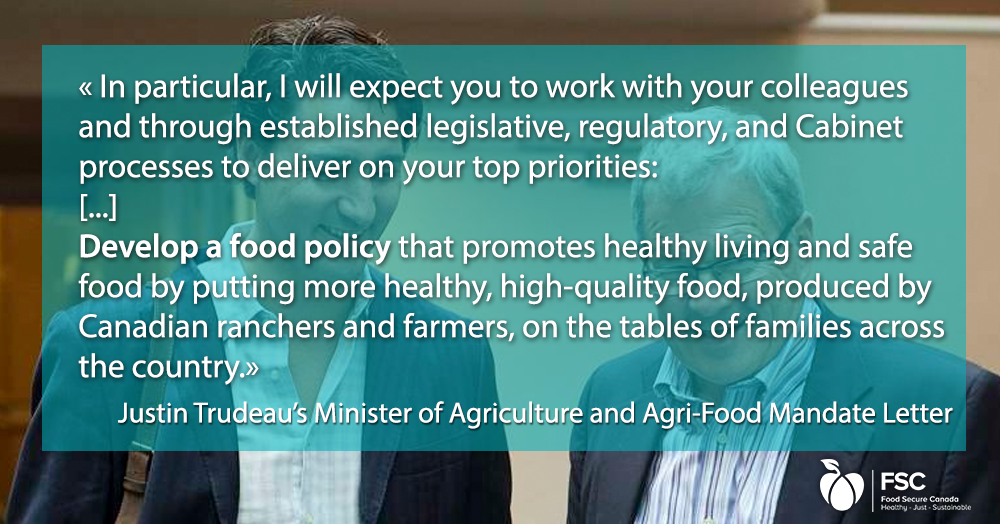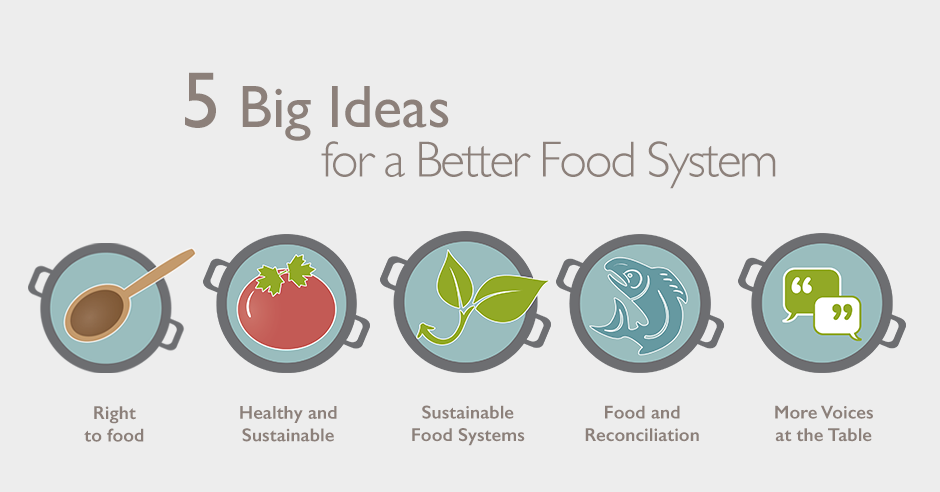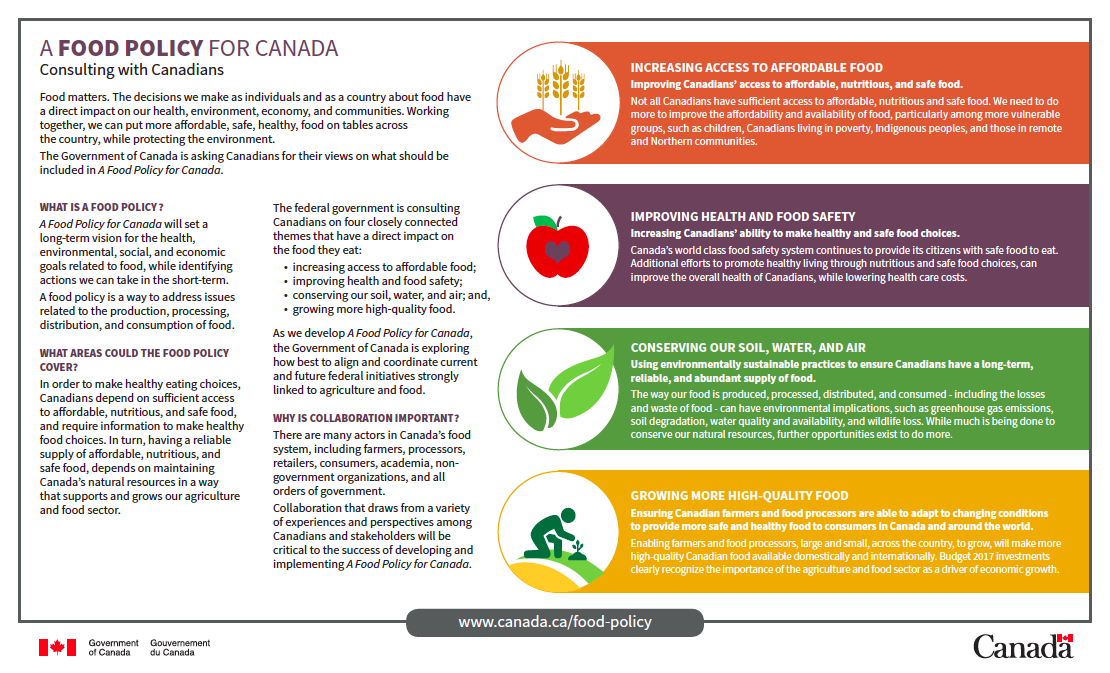Why a National Food Policy in Canada matters?
After years of lobbying by Food Secure Canada and others, the Trudeau government charged the Department of Agriculture and Agri-Food with leading the development of A Food  Policy for Canada (NFP). The Government received feedback from 45,000 Canadians during its public consultations. The Budget 2019 included a funding line for food policy that allocated $134 million dollars for specific initiatives, as well as announcing federal leadership towards a national healthy school food programme. The new federal policy will be announced shortly.
Policy for Canada (NFP). The Government received feedback from 45,000 Canadians during its public consultations. The Budget 2019 included a funding line for food policy that allocated $134 million dollars for specific initiatives, as well as announcing federal leadership towards a national healthy school food programme. The new federal policy will be announced shortly.
Why do we need a National Food Policy?
Why is National Food Policy on the official agenda now?
What has the government already decided and what happens next?
Which concrete policy ideas or proposals have already been developed?
Why is the idea of a National Food Policy Council being floated?
How does National Food Policy relate to other governmental promises and consultations?
1. Why do we need a National Food Policy?
Because our food system is disconnected in too many ways.
Food insecurity
- Canada is a leading agricultural exporter, yet four million Canadians struggle to put food on the table. Rates of food insecurity are twice
 as high among Indigenous populations, and catastrophic levels of hunger prevail in parts of northern Canada. (See: Findings of the mission to Canada by Olivier de Schutter, the UN Special Rapporteur on the Right to Food)
as high among Indigenous populations, and catastrophic levels of hunger prevail in parts of northern Canada. (See: Findings of the mission to Canada by Olivier de Schutter, the UN Special Rapporteur on the Right to Food)
Food-related chronic diseases
- Increasing amounts of highly processed food in our diets are contributing to the rise in chronic disease (diabetes, hypertension, obesity), which threatens to overwhelm our health care system. The Healthy Eating Strategy would be a significant step in the right direction, but has only been partially implemented so far.
Economic benefits
- We import 30% of our food despite the fact that we know that growing and processing our own food has many economic benefits, in addition to delivering the fresh, local food Canadians want to eat.
Indigenous food sovereignty
- Food has been used as an instrument of colonization and oppression in Canada, but it is a potential path to reconciliation if we recognize and support the practice of Indigenous food sovereignty.
Environmental impacts
- The price we pay for food ignores its environmental and health externalities -- that hamburger is not actually that cheap -- that we end up paying for down the line.
Industrial versus small-scale farming
- We support small farmers overseas but have a deliberate policy of exclusively encouraging bigger, more industrial farms at home.
Silos instead of systems thinking
- We need a coordinated approach with a food-systems lens that connects existing silos. We need to agree across silos and sectors (government, civil society, private sector) upon common goals to achieve a food system that is not only economically viable but also healthy, just and sustainable. That will require recognizing that food is not simply a commodity but a central aspect of our social, cultural, historical and environmental realities, with a tremendous impact on the quality of our lives as citizens and as communities.
- A national food policy that is truly “joined-up” would articulate a set of values and principles to guide food policy-making. It would define a mandate and trace an implementation plan, using all the tools that the federal government has at its disposal (policies, legislation, regulations, regulatory protocols and directives, programs, educational mechanisms, trade and investment treaties, intergovernmental agreements, taxes or tax incentives). To be effective, it would also require substantial changes to how and where decisions are made, incorporating more voices than are currently involved.
What is systems thinking?"Food policy development is a complex issue for policy makers because . . . it is about the intersections between a number of policy systems that are historically divided intellectually, constitutionally, and departmentally" (Rod MacRae, A Joined Up Food Policy for Canada). In order to put in place a national food policy that is as sustainable and equitable as it is efficient and competitive, we need a more systems-oriented approach. We often try to fix societal issues with a ‘’quick fix” that addresses the symptoms of a problem. These solutions can fail to have the impact we hope for as we haven’t accounted for the many forces that feed into a problem or addressed the underlying issues. A systems-thinking approach looks at patterns and feedback loops in order to identify key leverage points for change. Achieving a sustainable, healthy, just food system will require taking a systems approach of examining the root causes of problems and exploring and experimenting with potential solutions. Rather than trying to fix each problem one by one (say hunger, then health), a systems approach will look at the relationships among the different parts and coordinate interventions on critical leverage points (why chronic disease is higher among low-income groups). |
Watch this 2014 TEDx talk laying out the case for a national food policy
David Peter Stroh and Kathleen Zurcher, Acting and Thinking Systemically
Celebrating 10 Years of Collective Food Policy Action: 2008 - 2018
2. Why is National Food Policy on the official agenda now?
As part of his commitment to open and accountable government, Prime Minister Justin Trudeau published the mandate letters that he sent to each Minister in November 2015, detailing their policy priorities. The mandate letter to Minister Lawrence MacAulay of Agriculture and Agri-Food Canada (AAFC) includes this commitment :

Food Secure Canada wrote an open letter to Minister MacAulay calling for an inclusive, whole-of-government approach to developing the policy.
In October 2017 the mandate letter of the incoming Health Minister, Ginette Petitpas Taylor asked her to "Work closely with the Minister of Agriculture and Agri-Food to align these regulatory initiatives [ introducing new restrictions on the commercial marketing of unhealthy food and beverages to children, similar to those now in place in Quebec; bringing in tougher regulations to eliminate trans fats and to reduce salt in processed foods, similar to those in the United States; and improving food labels to give more information on added sugars and artificial dyes in processed foods] with food policy."
In March 2019 Marie-Claude Bibeau was appointed Minister of Agriculture and Agri-Food. Food Secure Canada wrote urging her to ensure that Canada’s first national food policy builds a more healthy, equitable and sustainable food system.
More resources:
Food Policy on the new Federal Government Agenda
3. What has the government decided already and what happens next?
The government’s A Food Policy for Canada is being developed around four pillars:
- Food Security
- Health
- Environment
- Sustainable Growth of the Agriculture and Food Sector
While AAFC is the lead Department, up to 12 other departments are engaged on the file, and there are many related mandates, such the revision of Canada’s Food Guide, the new Agricultural Policy Framework and Nutrition North, which are led by other departments. The challenge is making sure they are working together, rather than each pursuing different ends and responding to different constituencies.
In the summer of 2017 the government consulted with Canadians about the new policy, including 45,000 people who participated online. The What We Heard report from the consultations was published in September 2018.
The Budget 2019 included a funding line for food policy that allocated $134 million dollars for specific initiatives, as well as announcing federal leadership towards a national healthy school food programme.
4. Which concrete policy ideas or proposals have already been developed?
 Different actors in the the Canadian food system have been calling for a more unified food policy and developing partial or comprehensive platforms.
Different actors in the the Canadian food system have been calling for a more unified food policy and developing partial or comprehensive platforms.
In 2011, FSC published Resetting the Table: A People’s Food Policy for Canada - the result of three years of consultations involving 3,500 people. The menu of workable policies has the concept of food sovereignty at its heart and represents the most comprehensive national food policy document thus far.
During the 2015 federal election, Food Secure Canada’s Eat Think Vote campaign called for a national food policy with a focus on some key issues: healthy school food; affordable food in the North; support for new farmers; and zero hunger in Canada. Sixty-eight events across Canada brought together 164 election candidates and 4,461 participants, with millions reached through radio, television, newspapers and social media coverage. Five of the candidates who attended those events became Cabinet Ministers.
Five Big Ideas for a Better Food System is the proposal from Food Secure Canada for the national food policy, with organisations across the country having been invited to support it.
More resources:
- Summary of the policy session at our 9th Assembly: National Perspectives on a National Food Policy, which brought together FSC, the Canadian Federation of Agriculture, the Centre for Food in Canada, the Canadian Agri-Food Policy Institute and Assembly of First Nations.
- Anne Hui’s Why a New National Strategy on Food Can’t Satisfy All in The Globe and Mail
- Rod MacRae’s A little regulatory pluralism with your counter-hegemonic advocacy? Blending analytical frames to construct joined-up food policy in Canada
- Food Secure Canada's Policy Recommendations and Actions are gathered here
5. Why is the idea of a National Food Policy Council being floated?
One of the specific ideas already being discussed is the creation of a National Food Policy Council as an inclusive, transparent governance instrument that would work to ensure the implementation of the agreed national policy. Other ideas or solutions may well come out of the consultative process.
In the OpEd A National Food Policy Council for Canada, Dr. Rod MacRae explains how Food Policy Councils are already working at municipal and provincial levels across Canada and the rationale for considering a national council as part of the architecture of the forthcoming food policy.
In December 2017, an informal network of organizations from the food business, farming, civil society, philanthropic and academic sectors interested in national food policy, convened by the Arrell Food Institute at the University of Guelph, the Canadian Federation of Agriculture, Food Secure Canada, Maple Leaf Foods and the McConnell Foundation published the results of its work.
- Read the report The Case for a National Food Policy Council
- Read the joint press release
- Read the joint letter to Minister Lawrence MacAulay
More resources:
- Watch our webinar: National Perspectives on a National Food Policy
- Sasha McNicoll's executive summary, More Voices at the Table: The Case for a National Food Policy Council for Canada
- A companion document, National Food Policy Council of Canada Act, is a draft Bill for the federal parliament proposed by Food Secure Canada, addressing mandate, membership, meetings, funding and staffing of an eventual National Food Policy Council.
6. How can a national policy mesh with diverse international, provincial, territorial and municipal approaches?
This is undoubtedly one of the biggest challenges - to get to a cohesive, useful and ambitious national policy, while respecting other jurisdictions and inherently diverse local experiences, needs, and aspirations. Across Canada, there is a patchwork of provincial, territorial, and municipal food policies and strategies. One of Food Secure Canada’s goals will be to showcase municipal and provincial innovations and best practices that can inform the national policy.
Another goal is to get decisions about food closer to the people who are consuming that food, so there is no question of a one-size-fits-all policy. Rather, we need to foster local innovation and regional dynamism, and maximize job creation, positive health and environmental outcomes. The solutions will differ from one part of the country to the next; however, the overall goals and principles governing this system need to be debated, agreed upon and then implemented.
International trade and investment agreements, as well as Canada’s aid policies, are squarely in the federal remit. Are they contributing to our goals to have a healthier and more sustainable food system where no one goes hungry?
7. How does the National Food Policy relate to other governmental promises and consultations?
The primary challenge for the food movement is getting the best joined-up result in the context of the AACF-led process towards a National Food Policy. However, other federal consultations and policy development involving the food system are ongoing.
Among the recent or current consultations concerning various aspects of food policy, Food Secure Canada has been actively involved in:
- Nutrition North (see FSC’s submission)
- Canada’s Healthy Eating Strategy (including the new Food Guide, marketing to kids legislation and front-of-packaging labelling)
- Canada’s Agricultural Policy Framework (see the submission of the New Farmers Initiative)
Taken together, the reviews of these policies can be building blocks of a national food policy, but that requires joined-up vision and a common set of principles and priorities.
8. How can I get involved ?
We need the active participation of an expanded membership base to get the best national food policy that we can. Through newsletters, webinars and conference calls, Food Secure Canada members get informed and stay involved. Join us now!
Find out more about food policies in Canada
- Log in to post comments


